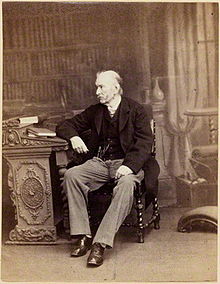Samuel Hunter Christie
Samuel Hunter Christie (born March 22, 1784 in London , † January 24, 1865 in Ailsa Villa, Twickenham , London) was a British mathematician and naturalist .
Live and act
Christie was born in London. He studied mathematics at Trinity College in Cambridge from 1800 , in the third year he received a scholarship. There he obtained a bachelor's degree as the second best of his class in 1805, and in his spare time he was one of the founders of the rowing club. From 1806 he worked as a mathematical assistant at the Royal Military Academy in Woolwich . There he taught mathematics as a professor from 1838 to 1854. In the course of his work, the examinations at the Academy in particular were largely changed due to his work. His research was mainly concerned with magnetism , new findings arose from research expeditions to the Arctic in 1818 and 1819, among other things. He presented a hypothesis derived from this in 1820 in the Philosophical Transactions . In June 1824 he presented some of his experiments on the influence of temperature on magnetism at a meeting of the Royal Society, the results of which were confirmed on an expedition under Parry.
In 1826 he was elected as a member (" Fellow ") of the Royal Society and from 1837 to 1854 also served as its secretary. In 1833 the Royal Society selected his work on the electromagnetic behavior of various metals as the Bacerian Lecture . In it he proves, for example, that the conductivity of different metals decreases with increasing length and improves with increasing diameter of the wire. He was also able to demonstrate the direct, non-thermal influence of sun rays on a magnetic needle . His hypothesis that the earth's magnetic field was due to the influence of the sun could not be proven experimentally.
He was the first to use a torsion balance to measure magnetic force, and he dealt with horizontally and vertically deflectable magnetic needles. He was on a committee for compasses . The part of the Report of the British Association for 1833 dealing with the earth's magnetic field and its possible causes is from Christie. Humboldt referred to Christie and George Airy in a letter to the President of the Royal Society in 1836 about observing the Earth's magnetic field . From this it emerged that from 1838 the United Kingdom set up permanently manned observation stations for the earth's magnetic field in several places on its territory.
As early as 1833, Christie described the basic principle of the Wheatstone Bridge in a document for the University of Cambridge . It was not until a few years later that Charles Wheatstone recognized its importance and its versatility. Wheatstone pointed to Christie as the inventor of the bridge, but this was named after Wheatstone because he had made its meaning and usability public. In The Genesis of the Wheatstone Bridge, Stig Ekelöf discusses the contributions of Christie and Wheatstone, and why the bridge was named Wheatstones.
From 1864 Christie temporarily moved to Lausanne for health reasons. He was married twice, first marriage from May 12, 1808 until her death on May 27, 1829 to Elizabeth Theodora, eldest daughter of Charles Claydon, Battler of Trinity College, Cambridge. Her tomb is in All Saints Church, Cambridge. His second marriage was on October 16, 1844, with Margaret Ellen, daughter of James Malcolm of Killarney. His son was the astronomer William Christie .
Cape Christie on the east coast of Victoria Land is named after Christie in Antarctica . The same applies (in incorrect spelling) to Mount Christi , a mountain on Smith Island in the archipelago of the South Shetland Islands.
literature
- George Clement Boase : Christie, Samuel Hunter . In: Leslie Stephen (Ed.): Dictionary of National Biography . Volume 10: Chamber - Clarkson. MacMillan & Co, Smith, Elder & Co., New York City / London, 1887, pp 284 - 285 (English).
- Frank AJL James: Christie, Samuel Hunter (1784-1865). In: Henry Colin Gray Matthew, Brian Harrison (Eds.): Oxford Dictionary of National Biography , from the earliest times to the year 2000 (ODNB). Oxford University Press, Oxford 2004, ISBN 0-19-861411-X , ( oxforddnb.com license required ), as of 2004 (not viewed).
Web links
- Entry on Christie, Samuel Hunter (1784–1865) in the Archives of the Royal Society , London
Individual evidence
- ↑ The Christie according to information in the Dictionary of National Biography , also adopted by Venn, in which 90 Pall Mall in London was born, is according to information in 'Leicester Square, West Side: Leicester Estate: Nos 43-54 Leicester Square', Survey of London: Vol. 33 and 34: St Anne Soho (1966), pp. 507-514 ( british-history.ac.uk , English) improbable. His father probably had the same name and was probably about the same age as the auctioneer listed there, but he was a tailor. Christie apparently grew up in Leicester Square (see no. 48 there and note c).
- ↑ Christie, Samuel Hunter . In: John Archibald Venn (Ed.): Alumni Cantabrigienses . A Biographical List of All Known Students, Graduates and Holders of Office at the University of Cambridge, from the Earliest Times to 1900. Part 2: From 1752 to 1900 , Volume 2 : Chalmers – Fytche . Cambridge University Press, Cambridge 1944, pp. 35 ( venn.lib.cam.ac.uk Textarchiv - Internet Archive ).
- ^ Stig Ekelöf: The Genesis of the Wheatstone Bridge . In: Engineering Science and Education Journal . tape 10 , no. 1 , February 2001, p. 37-40 .
| personal data | |
|---|---|
| SURNAME | Christie, Samuel Hunter |
| BRIEF DESCRIPTION | British mathematician and naturalist |
| DATE OF BIRTH | March 22, 1784 |
| PLACE OF BIRTH | London |
| DATE OF DEATH | January 24, 1865 |
| Place of death | Ailsa Villa, Twickenham , London |
